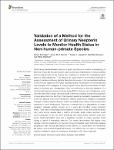Validation of a Method for the Assessment of Urinary Neopterin Levels to Monitor Health Status in Non-human-primate Species
Behringer, Verena
Stevens, Jeroen M. G.
Leendertz, Fabian H.
Hohmann, Gottfried
Deschner, Tobias
Determining individual health status is of great importance for a better understanding of life history trade-offs between growth, reproduction, and maintenance. However, existing immunological methods are invasive and therefore not suitable for investigating health status in wild populations. Thus, there is an urgent need for non-invasive methods to assess the immune status of animals. Neopterin is involved in the cell-mediated pathway of the immune response (Th1–type), secreted during the activation of monocytes and macrophages. We investigated if urinary neopterin could serve as a biomarker of health status in bonobos and chimpanzees. First, we performed a chemical validation of a commercial neopterin enzyme immune assay (EIA) for bonobo and chimpanzee urine. We then examined if urinary neopterin levels in bonobos increase during the acute period of respiratory infections. We found that neopterin levels can be reliably measured in urine of the two species with a commercial EIA. Stability experiments revealed considerable changes in urinary neopterin levels in relation to multiple freeze–thaw cycles and extended exposure to room temperature. Exposure to sunlight led to a degradation of urinary neopterin, whereas sample storage up to 2 years did not affect urinary neopterin levels. There was no detectable diurnal variation in neopterin levels, and levels remained very stable across several days in healthy individuals. While urinary neopterin levels were independent of sex, non-adult individuals had higher urinary neopterin levels than adults. Most importantly, there was a significant increase in urinary neopterin levels during a period of respiratory infection. Our results demonstrate that regular urine sample collection would allow for the monitoring of individual health status and disease progression with minimal disturbance of the subjects. In combination with behavioral, life history, and endocrinological parameters, the method can be used to investigate questions related to immunocompetence handicaps or life history trade-offs.
No license information

